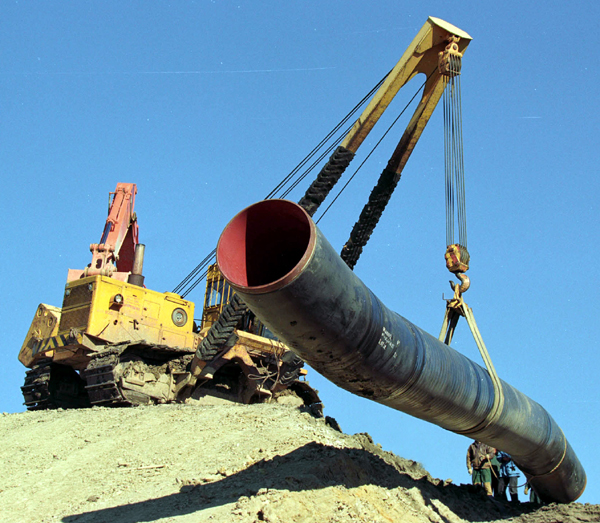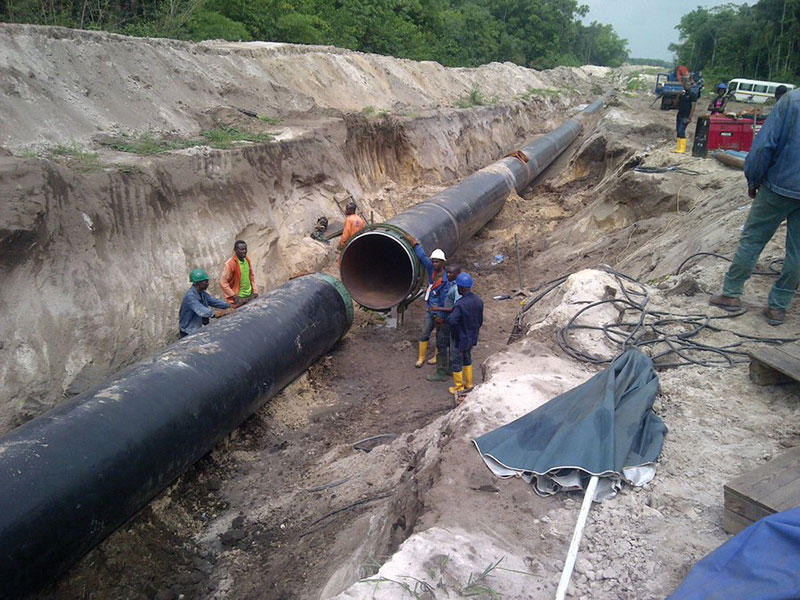April 2022, Vol. 249, No. 4
Projects
Projects April 2022
Nord Stream 2 Owner Considers Insolvency After Pipeline Halt, Sanctions
The operator of the Russia-led gas pipeline project Nord Stream 2 said in early March it had to terminate contracts with employees because of U.S. sanctions.
The Swiss-based company is considering filing for insolvency, two sources familiar with the situation told Reuters, as it attempts to settle claims ahead of a U.S. sanction deadline for other entities to stop dealings with it.
Nord Stream 2 AG, which is registered in Switzerland and owned by Russian state-owned gas giant Gazprom, last year completed the $11 billion project that was designed to double the capacity to pump gas from Russia to Germany.
The two sources, who spoke on condition of anonymity because the talks about potential insolvency are confidential, said that Nord Stream 2 AG has been working with a financial adviser on clearing some of its liabilities and could formally begin insolvency proceedings in a Swiss court as soon as this week.
Nord Stream 2 AG did not comment on possible insolvency. Gazprom declined to comment.
The 767-mile (1,230-km) pipeline had not begun commercial operations because it was pending certification in Germany, which last week put this process on hold as a result of the escalating Ukraine crisis.
Gazprom paid half the cost of building Nord Stream 2, with the remainder of the $11 billion pipeline project financed by British oil and gas major Shell, Austria's OMV, France’s Engie and Germany’s Uniper and Wintershall DEA.
It was unclear whether all entities related to Nord Stream 2 AG would be shut down or how Gazprom plans to proceed with the pipeline maintenance.
Energy Transfer Eyes Permian Gas Pipeline, Starts Gulf Run
Energy Transfer joined at least two other companies looking to build the next pipeline to transport growing natural gas production from the Permian Basin to export hubs on the Gulf Coast, according to Reuters.
Energy Transfer said the company expects to complete Gulf Run by the end of 2022.
“Given the proposed route and our ability to utilize existing assets, we believe we could complete construction of the [Permian] project in two years or less once we have reached FID [final investment decision],” Energy Transfer Co-Chief Executive Thomas Long told analysts on an earnings call.
With production growing fast in the Permian and demand rising from new liquefied natural gas (LNG) export plants on the Gulf Coast, some other companies are also looking to add new gas pipelines in the region, including units of Kinder Morgan and MPLX.
Analysts at Mizuho said Energy Transfer likely squeezed past Kinder Morgan into the lead position to build the next Permian pipeline since Energy Transfer’s project could add 1.5 to 2 Bcf/d (42 to 57 MMcm/d) of transport capacity with only around 260 miles (418 km) of new pipe.
Additionally, Energy Transfer said it started building the Gulf Run pipeline in Louisiana to move gas from the Haynesville Shale in Texas, Arkansas and Louisiana to the Gulf Coast.
Gas Pipeline in Ukraine Damaged by Fighting, Local Governor Says
Ukrainian engineers scrambled March 6 to repair a gas pipeline damaged by Russian forces, halting supplies to parts of southeastern Ukraine, the Donetsk region Gov. Pavlo Kyrylenko said.
Engineers had shut down the pipe to prevent gas from leaking, he said, adding that gas flow downstream was now dropping and would stop completely later in the day.
Kyrylenko said that every location between the town of Vuhledar in the Donetsk region and the port of Berdyansk would be left without gas while the damage is repaired. The distance between the two towns is 73 miles (117 km).
“We are working hard to remove this problem as quickly as possible,” Kyrylenko told Reuters.
Cowboy Midstream Plans New Crude Offload Terminal
Cowboy Midstream, a full-service midstream provider, plans to open its Ross Road Terminal, a crude oil truck offload facility in the Powder River Basin. The terminal will be capable of offloading and shipping Powder River crude in volumes of up to 20,000 bpd.
The terminal is placed strategically in the Powder River Basin and is tied into Cowboy Midstream’s Powell Lateral II pipeline. Ross Road Terminal will initially include truck offloading lease automatic custody transfers (LACTs), storage capacity of 10,000 barrels, full power distribution centers/motor control centers (PDC/MCC), and pipeline pumps.
The Powell Lateral II pipeline is connected into a larger transmission system that will give shippers the opportunity to access and capitalize on multiple downstream markets for their Powder River crude.
“Cowboy is excited to place its crude transportation system in operation to bring high-quality Rocky Mountain sweet crude to market via its low-cost Powell Lateral II transportation system connected to the Midwest, Wyoming and all destinations beyond,” said Gregg Werger, managing operations partner at Cowboy Midstream.
Construction activities are underway, and Cowboy expects the new terminal to be ready for crude oil receipt and transportation this month.
Regional Pact Puts Trans-Saharan Gas Pipeline Back on Track
Niger, Algeria and Nigeria have signed an agreement that will see development resume on the multibillion-dollar Trans-Saharan gas pipeline project, the African Energy Chamber announced.
Niger’s Minister of Petroleum, Energy and Renewable Energies, Algeria’s Minister of Energy and Mines and Nigeria’s Minister of State for Petroleum Resources signed the three-nation pact, which was finalized during the Economic Communities of West African States (ECOWAS) Mining and Petroleum Forum recently in Niamey, Niger.
With a length of 2,565 miles (4,128 km), the $13 billion pipeline will link Warri in Nigeria to Hassi R’Mel in Algeria, passing through Niger. Upon completion, the pipeline will carry 30 Bcm (850 MMcm) of natural gas yearly to European markets via Algeria’s strategic Mediterranean coast, as well as supply inland stations along its route.
“This project will be transformational for all the countries involved and we in Nigeria are committed wholly to making it a success,” said Minister H.E. Mahamane Sani Mahamadou of Niger. “It will bring jobs and much-needed revenue from gas monetization.”
The Trans-Saharan Gas Pipeline would enable Europe to tap directly into the three country’s significant natural gas reserves, helping it diversify its supply sources while creating critical sources of revenue for African gas markets.
Much of the estimated $13 billion pipeline cost will be spent in Niger, acting as a much-needed boost for the already growing energy sector and wider economy. It would also enable Niger to monetize its own gas reserves, estimated at 34 Bcm (963 MMcm), with recoverable reserves of 24 Bcm (680 MMcm).
Norway Approves Development of Equinor’s Kristin South Project
Norway endorsed the development of several Equinor-operated gas and condensate discoveries in the Norwegian Sea, according to the Ministry for Petroleum and Energy.
Along with its partners, Equinor plans to invest $742 million (6.5 billion Norwegian crowns) in several discoveries in the Kristin Field region, estimated to hold 58 MM boe.
The Kristin South Phase 1 should begin production in 2024, with gas exportation to Europe occurring on an existing offshore pipeline system, the Ministry said.
Partnering with Equinor in the venture are Petoro, Eni’s Norwegian subsidiary Vaar Energi and TotalEnergies.
Canada Condemns Attack on Coastal GasLink Work Camp
The Canadian government condemned an attack on a Coastal GasLink pipeline work camp in northern British Columbia, in which police said assailants brandishing axes threatened workers and damaged equipment.
Coastal GasLink, a subsidiary of Calgary-based TC Energy, is building the 420-mile (670-km) pipeline to the west coast of British Columbia to supply the planned liquefied natural gas project LNG Canada.
The attack came as police in the capital of Ottawa started arresting protesters involved in a three-week trucker-led blockade that had prompted Prime Minister Justin Trudeau to assume emergency powers.
Coastal GasLink said about 20 masked attackers wearing camouflage surrounded a work site off a forest service road and attacked workers early in the morning. They wielded axes, fired flare guns and tried to set one vehicle on fire while workers were inside, the company said in a statement.
The workers fled and the attackers vandalized heavy equipment and construction trailers, causing millions of dollars of damage, the company added.
Low-Carbon Pipeline Projects May Total 42 mtpa Capacity
A large proportion of hydrogen pipeline projects in the feasibility phase brings the global low-carbon hydrogen project capacity to 42 million tons per annum (mtpa), GlobalData announced.
This puts the global hydrogen energy transition market on track to becoming a major global energy source, the GlobalData report states, and positions 2022 as a crucial time for progressing final investment and construction decisions.
“Hydrogen is becoming popular as a low or zero-carbon energy source in demand segments such as energy storage, buildings, and transportation. Many countries have begun to consider a hydrogen-based economy to support decarbonization,” said Barbara Monterrubio, an energy transition analyst at GlobalData. “Green hydrogen presently has a small share in the hydrogen production mix but is poised to increase, given the ambitious targets announced by countries and companies.”
Green hydrogen is produced with renewable energy, making it climate-neutral. Blue hydrogen, which is produced using natural gas, makes up most active hydrogen capacity, but most of the post-feasibility and feasibility phase projects are green hydrogen, GlobalData shows.
More than two-thirds of the 42 mtpa of upcoming capacity will come from the former Soviet Union, Europe and Oceania, of which 87% and 12% come from green and blue, respectively, and less than 0.5% come from purple and turquoise projects, according to GlobalData. Purple hydrogen is hydrogen produced with nuclear energy.
During the fourth quarter of 2021, 33 countries announced new low-carbon hydrogen plants, with projects in Australia, Chile and the United States adding 3 mtpa capacity to the global hydrogen pipeline.
Nord Stream 1 Says Gas Supplies to Europe Via Pipeline Continue
The operator of the operational Nord Stream 1 undersea gas pipeline from Russia to Germany said that transportation of natural gas to Europe was continuing normally.
“Nord Stream AG is not involved in the Nord Stream 2 project and not engaged in the activities of Nord Stream 2 AG. Nord Stream AG is, therefore, not targeted by the sanctions against Nord Stream 2 AG neither by any other sanctions,” it said in a statement. “Consequently, Nord Stream AG is able to execute its payments and settlements.”







Comments